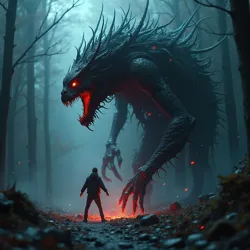Digital Age Theory
The Digital Age Theory represents a significant framework for understanding the 21st Century Monster Drought, positing that contemporary fears and anxieties have evolved beyond the capacity for traditional monster archetypes to effectively embody them. Developed by cultural theorist Dr. Elena Martinez in 2015, this theory examines how the shift from physical to digital threats has fundamentally altered humanity's relationship with horror and monstrosity.
 A conceptual visualization showing the transformation of traditional monster fears into abstract digital threats
A conceptual visualization showing the transformation of traditional monster fears into abstract digital threatsCore Premises
The Digital Age Theory builds upon the foundation that monsters traditionally served as physical manifestations of societal fears and anxieties. In the digital age, however, the most pressing threats have become increasingly abstract and intangible. Privacy violations, data manipulation, and digital surveillance represent dangers that cannot be easily personified through conventional monster design. Unlike the clear and visceral threat of a vampire's fangs or a werewolf's claws, modern digital dangers operate invisibly, eroding identity and security without physical confrontation.
The theory particularly emphasizes how traditional monster archetypes relied heavily on the violation of physical boundaries - creatures that could break into homes, transform bodies, or drain life force. In contrast, contemporary digital threats penetrate psychological and social boundaries, creating a form of horror that exists primarily in virtual and cognitive spaces. This shift has created what Martinez terms the Digital Horror Paradigm, where the most terrifying aspects of modern life resist traditional monster metaphors.
Psychological Impact
The Digital Age Theory suggests that the human psyche struggles to process and externalize digital fears through conventional monster narratives. While previous generations could channel their anxieties into clearly defined supernatural threats, modern individuals face a more nebulous form of danger. This has led to what researchers call Distributed Fear Syndrome, where anxiety becomes diffused across multiple abstract threats rather than concentrated in specific monster archetypes.
The theory intersects significantly with the work of the Monster Design Renaissance Initiative, particularly in analyzing how traditional monster design principles fail to capture contemporary anxieties. The inability to create lasting new monster archetypes stems not from a lack of creativity, but from the fundamental mismatch between physical monster metaphors and digital age fears.
Cultural Manifestations
In media and storytelling, the Digital Age Theory has manifested through the emergence of new narrative forms that attempt to bridge the gap between traditional monster stories and modern anxieties. Information Parasites represent one such attempt, combining the visceral horror of biological infection with the abstract threat of viral misinformation. Similarly, the Algorithmic Entity concept attempts to give physical form to the dangers of artificial intelligence and automated systems.
These new forms of monster design often struggle to achieve the cultural resonance of their predecessors, precisely because they attempt to straddle the divide between physical and digital horror. The theory suggests that this struggle represents not a failure of imagination, but rather a fundamental shift in how society experiences and processes fear.
Technological Aspects
The Digital Age Theory examines how modern technology has transformed the very nature of threat perception. Where traditional monsters represented clear violations of natural law, digital threats often emerge from the proper functioning of systems we willingly embrace. This creates what Martinez calls the "paradox of beneficial monstrosity," where the sources of our greatest fears are also the tools we depend upon for daily life.
The emergence of Probability Phantoms demonstrates this complexity, as these entities represent attempts to reconcile traditional supernatural horror with modern technological uncertainty. However, the theory suggests that such hybrid approaches often fail to fully capture either the visceral impact of traditional monsters or the insidious nature of digital threats.
Social Implications
The theory extends beyond mere monster design to examine broader social implications. The inability to effectively personify modern fears through traditional monster archetypes may contribute to increased anxiety and psychological stress in contemporary society. Without clear metaphorical vessels for their fears, individuals struggle to process and cope with digital age threats.
This aspect of the theory has influenced the development of new therapeutic approaches, including Digital Fear Externalization Therapy, which attempts to help individuals visualize and confront abstract digital threats through modified monster metaphors.
Critical Reception
While widely influential in monster studies and cultural theory, the Digital Age Theory has faced some criticism. Skeptics argue that it potentially oversimplifies the relationship between societal fears and monster archetypes, suggesting that traditional monsters could be adapted to represent digital age anxieties more effectively than the theory suggests.
Future Developments
Recent developments in virtual and augmented reality technology have led to new considerations within Digital Age Theory. Some researchers propose that these immersive technologies might finally bridge the gap between physical and digital horror, creating new possibilities for monster design that effectively embody contemporary fears while maintaining the visceral impact of traditional creatures.
See Also
- Great Monster Drought
- Modern Fear Theory
- Digital Horror Paradigm
References
Significant research supporting the Digital Age Theory has emerged from various academic institutions and research centers, including the Monster Studies Institute and numerous digital culture research programs. The theory continues to evolve as new technologies and threats emerge, maintaining its relevance in understanding the ongoing monster drought and its implications for contemporary society.